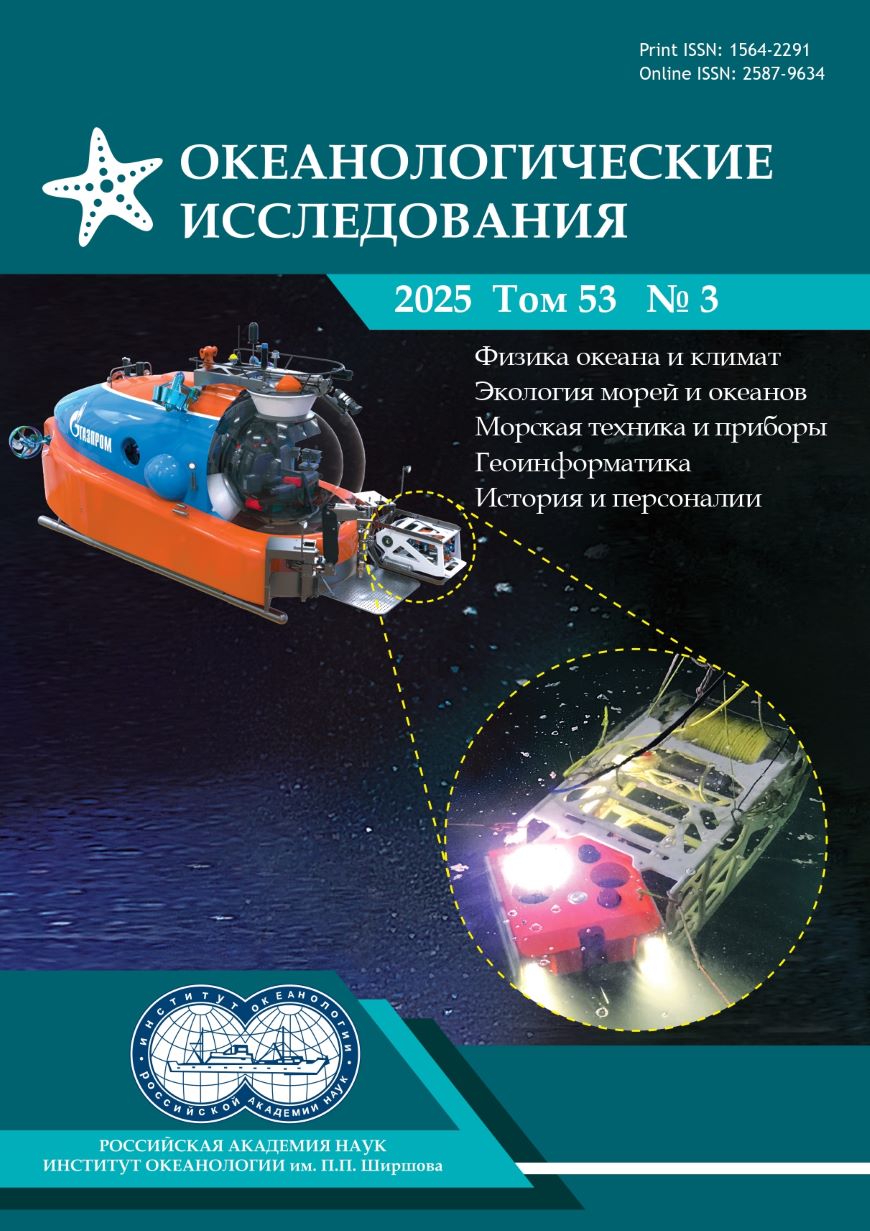ASSESSING THE APPLICABILITY OF SATELLITE RADAR DATA FOR DETECTING RIVER PLUMES IN THE SOUTHERN PART OF THE GULF OF RIGA
Abstract
This study investigates the potential and constraints of river plume identification in the southern Gulf of Riga using satellite synthetic aperture radar (SAR) imagery from 2022–2024. The research evaluates SAR data’s capacity to delineate plume boundaries and monitor their seasonal and interannual variability. The visibility of plumes in SAR images arises from capillary wave modulation at freshwater-seawater interfaces and surfactant-induced suppression of short-wave turbulence. Winter conditions improve plume visibility through ice-associated river discharge, clearly detectable in SAR images. Through the See the Sea (STS) monitoring system, 62 plumes were identified from three rivers: the Daugava (Western Dvina), Lielupe, and Gauja. The Daugava exhibited the most extensive plumes, reflecting its large watershed and high discharge volumes. Maximum plume expansion occurred in 2023, with the Lielupe and Gauja plumes covering 2–4 times larger areas than in 2022. Although 2024 saw reduced activity, plume metrics remained elevated above baseline levels. The results demonstrate that SAR data can effectively track river plumes under specific hydrometeorological conditions, proving valuable for environmental monitoring, water resource management, and coastal anthropogenic impact assessments in the Baltic region.
References
- Cresswell, G. R. and P. C. Tildesley, 2000: Detecting tropical river plumes and island wakes with Radarsat, Canadian Journal of Remote Sensing, 26 (4), 267–272, https://doi.org/10.1080/07038992.2000.10874777.
- Dierking, W. and J. Dall, 2007: Sea-Ice Deformation State From Synthetic Aperture Radar Imagery – Part I: Comparison of C- and L-Band and Different Polarization. IEEE Transactions on Geoscience and Remote Sensing, 45 (11), 3610–3622, https://doi.org/10.1109/TGRS.2007.903711.
- Food and agriculture Organization of the United Nations. Irrigation in the countries of the former Soviet unions in figures: report in Food and Agriculture Organization of the United Nations), Rome, 1997, https://www.fao.org/4/w6240e/w6240e00.htm.(last accessed in 22.07.2025).
- Hessner, K., A. Rubino, P. Brandt, and W. Alpers, 2001: The Rhine outflow plume studied by the analysis of synthetic aperture RADAR data and numerical simulations. J. Physical Oceanography, 31 (10), 3030–3044, https://doi.org/10.1175/1520-0485(2001)031<3030:TROPSB>2.0.CO;2.
- Ivanov, A. Yu., D. V. Khlebnikov, B. V. Konovalov, N. V. Evtushenko, and N. V. Terleeva, 2018: Osobennosti otobrazheniya vynosov rek v Chyornom more v dannyh distancionnogo zondirovaniya (Manifestations of river outflows in the Black Sea in remote sensing data). Sovremennye problemy distantsionnogo zondirovaniya Zemli iz kosmosa, 15 (5), 191–202, https://doi.org/10.21046/2070-7401-2018-15-5-191-202.
- Jay, D. A., J. Pan, P. M. Orton, and A. R. Horner-Devine, 2009: Asymmetry of Columbia River tidal plume fronts. J. Marine Systems, 78 (3), 442–459, https://doi.org/10.1016/j.jmarsys.2008.11.015.
- Jiang, L., X-H. Yan, and V. Klemas, 2009: Remote sensing for the identification of coastal plumes: case studies of Delaware Bay. Intern. J. Remote Sensing, 30, 2033–2048, https://doi.org/10.1080/01431160802549211.
- Klemas, V., 2012: Remote sensing of coastal plumes and ocean fronts: Overview
and case study. J. Coastal Research, 28 (1A), 1–7, https://doi.org/10.2112/JCOASTRES-D-11-00025.1. - Krengel, F., C. Bernhofer, S. Chalov, V. Efimov, L. Efimova, L. Gorbachova, M. Habel, B. Helm, I. Kruhlov, Y. Nabyvanets, N. Osadcha, V. Osadchyi, T. Pluntke, T. Reeh, P. Terskii, and D. Karthe, 2018: Challenges for transboundary river management in Eastern Europe – three case studies. DIE ERDE – Journal of the Geographical Society of Berlin, 149 (2–3), 157–172, https://doi.org/10.12854/erde-2018-389.
- Lavrova, O. Yu., E. V. Krayushkin, D. M. Soloviev, M. N. Golenko, N. N. Golenko, N. A. Kalashnikova, and A. N. Demidov, 2014: Vliyanie vetrovogo vozdejstviya i gidrodinamicheskih processov na rasprostranenie vod Kaliningradskogo zaliva v akvatorii Baltijskogo morya (Influence of wind and hydrodynamic processes on propagation of the Vistula lagoon waters into the Baltic Sea). Sovremennye problemy distantsionnogo zondirovaniya Zemli iz kosmosa, 11 (4), 76–99.
- Lavrova, O. Yu., M. I. Mityagina, and A. G. Kostianoy, 2016: Sputnikovye metody vyyavleniya i monitoringa zon ekologicheskogo riska morskikh akvatorii (Satellite methods for detecting and monitoring marine zones of ecological risk), Moscow, IKI RAS, 334 p.
- Lavrova, O. Yu., M. I. Mityagina, I. A. Uvarov, and E. A. Loupian, 2019: Tekushchie vozmozhnosti i opyt ispol’zovaniya informacionnoj sistemy See the Sea dlya izucheniya i monitoringa yavlenij i processov na morskoj poverhnosti (Current capabilities and experience of using the See the Sea information system for studying and monitoring phenomena and processes on the sea surface). Sovremennye problemy distantsionnogo zondirovaniya Zemli iz kosmosa, 16 (3), 266–287, https://doi.org/10.21046/2070-7401-2019-16-3-266-287.
- Loupian, E. A., A. A. Matveev, I. A. Uvarov, T. Yu. Bocharova, O. Yu. Lavrova, and M. I. Mityagina, 2024: Sputnikovyj servis See The Sea – instrument dlya izucheniya processov i yavlenij na poverhnosti okeana (The Satellite Service See the Sea – a tool for the study of oceanic phenomena and processes). Sovremennye problemy distantsionnogo zondirovaniya Zemli iz kosmosa, 21 (5), 321–332.
- Mityagina, M. I. and O. Yu. Lavrova, 2024: Vozmozhnosti sputnikovogo radiolokacionnogo nablyudeniya plyumov rechnyh i lagunnyh vod v yugo-vostochnoj chasti Baltijskogo morya (Feasibility of satellite radar observation of river and lagoon plumes in the southeastern Baltic Sea). Sovremennye problemy distantsionnogo zondirovaniya Zemli iz kosmosa, 21 (5), 288–305, https://doi.org/10.21046/2070-7401-2024-21-5-288-305.
- NASA/GES DISC. Giovanni: Interactive Online Visualization and Analysis Tool, https://giovanni.gsfc.nasa.gov/giovanni/.(last accessed in 22.07.2025).
- Osadchiev, A. and A. Yankovsky, 2022: Editorial: River plumes and estuaries. Frontiers in Marine Science, 9, https://doi.org/10.3389/fmars.2022.986114.
- Sletten, M., G. O. Marmorino, and T. F. Donato, 1999: An airborne, real aperture radar study of the Chesapeake Bay outflow plume. J. Geophysical Research, 104 (C1), 1211–1222, https://doi.org/10.1029/1998JC900034.
- Vogelzang, J., K. G. Ruddick, and J. B. Moens, 1997: On the signatures of river outflow fronts in radar imagery. Intern. J. Remote Sensing, 18, 3479–3505.
- Yurkovskis, A., and R. Poikāne, 2008: Biogeochemical, physical and anthropogenic transformations in the Daugava River estuary and plume, and the open Gulf of Riga (Baltic Sea) indicated by major and trace elements. Journal of Marine Systems, 70, 77–96, https://doi.org/10.1016/j.jmarsys.2007.03.003.
- Zhang, X., E. M. Twarog, D. J. McLaughlin, M. A. Sletten, G. O. Marmorino, C. L. Trump, and N. Allan, 2004: Radar scattering behavior of estuarine outflow plumes. IEEE Trans. Geoscience and Remote Sensing, 42 (2), 367–379, https://doi.org/10.1109/TGRS.2003.821056.
- Zheng, Q., P. Clemente-Colon, X.-H. Yan, W. Timothy Liu, and N. E. Huang, 2004: Satellite synthetic aperture radar detection of Delaware Bay plumes: Jet-like feature analysis. J. Geophysical Research, 109 (C3), C03031.1–C03031.11, https://doi.org/10.1029/2003JC002100.
Transfer of copyrights occurs on the basis of a license agreement between the Author and Shirshov Institute of Oceanology, RAS










